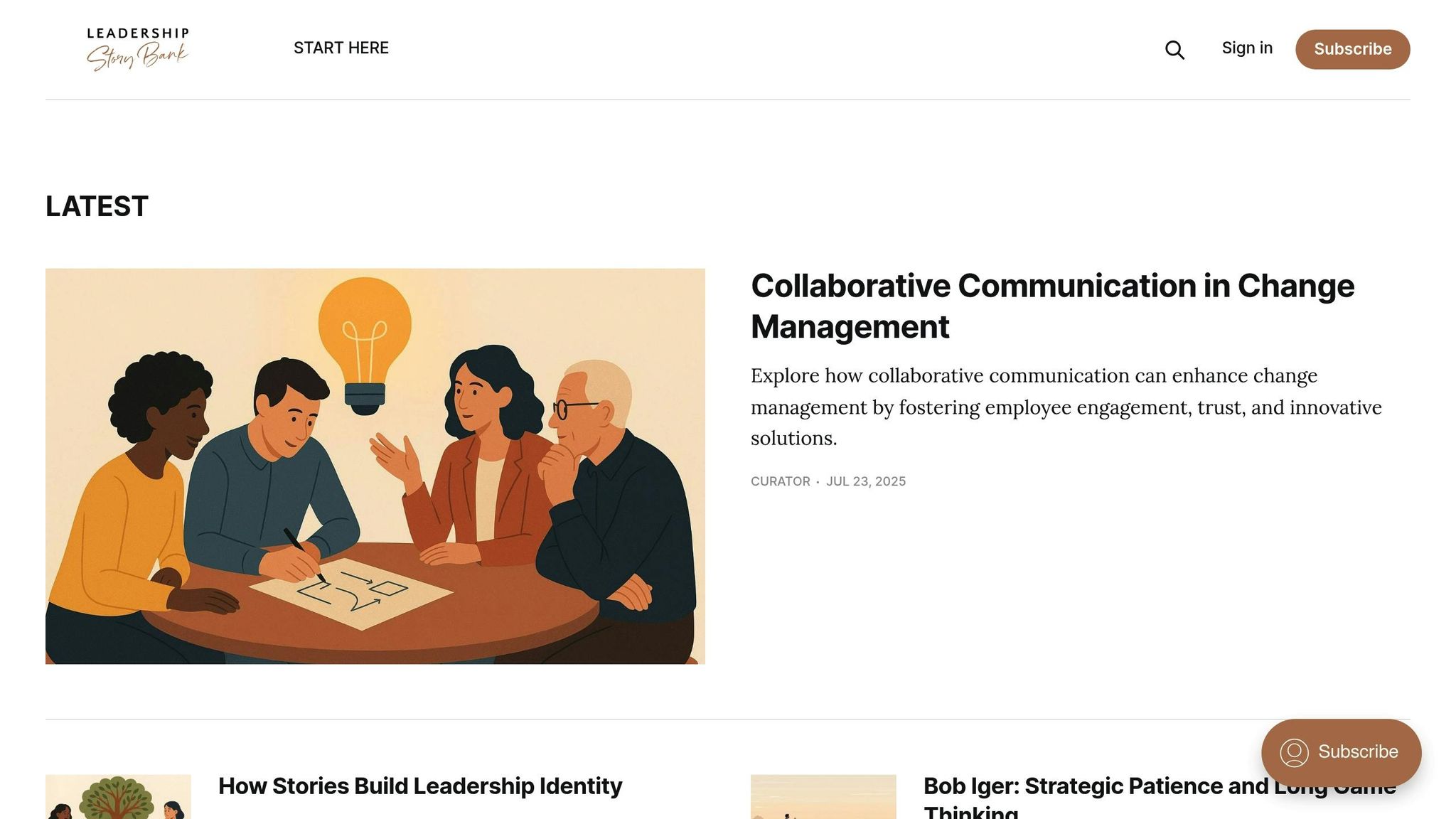Mahatma Gandhi: The Voice of Peace and Disruption
Explore the timeless leadership lessons of nonviolence, truth, and service that continue to resonate in today's world.

Mahatma Gandhi’s leadership philosophy, rooted in nonviolence and truth, offers timeless lessons for tackling today’s challenges. His ability to inspire change without force, relying instead on moral conviction and personal sacrifice, redefined what leadership can achieve. From the Salt March to his emphasis on simplicity, Gandhi showed that true influence comes through service, integrity, and connection.
Key takeaways:
- Nonviolence as strength: Gandhi’s principle of Ahimsa (non-harm) wasn’t passive but an active force for change.
- Truth as a foundation: Satyagraha (truth-force) demonstrated the power of standing firm in values.
- Trust-building: Gandhi led by example, earning respect through consistency and fairness.
- Symbols and storytelling: Tools like the spinning wheel and his personal narratives united millions.
- Modern relevance: His focus on humility, service, and moral courage resonates with today’s leadership needs.
Gandhi’s approach continues to inspire movements and leaders around the world, proving that ethical leadership is both powerful and enduring.
Leadership Lessons from Mahatma Gandhi | Timeless Wisdom for Modern Leaders
The Basics of Nonviolent Leadership
Gandhi redefined leadership by challenging traditional power structures, relying on moral authority and steadfast principles. His approach remains a powerful example of leadership that transcends time.
Core Values: Ahimsa and Satyagraha
At the centre of Gandhi’s leadership were two deeply intertwined principles: Ahimsa (nonviolence) and Satyagraha (truth-force). These weren’t mere ideals but the foundation of his every action. Gandhi developed the concept of Satyagraha in 1906, during his resistance to discriminatory laws targeting Asians in South Africa. The term translates to "holding onto truth" and, as Gandhi described, embodies both love-force and soul-force. This wasn’t passive resistance but an active, moral engagement with opponents, aiming to persuade rather than compel.
Practising these values required incredible discipline. For Gandhi, Ahimsa wasn’t just a tactic; it needed to be part of one’s very essence. Leaders committed to nonviolence had to live the change they wanted to see, accepting personal sacrifice instead of causing harm to others. His first Indian Satyagraha campaign in Champaran in 1917 demonstrated how truth-force could create meaningful change without violence.
Building Trust and Legitimacy
Gandhi’s unwavering commitment to his principles earned him profound trust - not through grand speeches or promises, but through personal sacrifice and consistency. Unlike leaders who sought control, Gandhi aimed to transform opponents by setting a moral example. Even in his legal career, he focused on reconciliation rather than confrontation.
"The Satyagrahi's object is to convert, not to coerce, the wrongdoer."
- Mahatma Gandhi
A striking example of this came during the 1914 South African campaign, when Gandhi paused mass Satyagraha to avoid exploiting his adversaries’ vulnerability. General Smuts’ secretary captured the effect of Gandhi’s approach:
"I do not like your people. But what I am to do? You help us in our days of need. You will not injure even the enemy. You desire victory by self-suffering alone and never transgress your self-imposed limits of courtesy and chivalry. And that reduces us to sheer helplessness."
These moments highlight how Gandhi’s integrity and fairness - even towards his opponents - built a moral authority that conventional power structures couldn’t rival. His honourable compromises and refusal to exploit weaknesses solidified his leadership. For instance, during the 1906 Transvaal campaign, Indians united to resist a degrading ordinance. By 1913, hundreds, including women, willingly faced imprisonment, and thousands endured floggings and jail time for the cause.
Blending Old Values with Modern Leadership
Gandhi’s brilliance lay in his ability to merge traditional Indian values with the demands of modern leadership. He didn’t reject modernity but showed how ancient wisdom could address contemporary challenges more effectively than conventional methods. Influenced by his family’s Vaishnava traditions and Jain ideals of nonviolence, Gandhi transformed these teachings into a practical philosophy that resonated with a wide audience.
"Here religion does not mean sectarianism. It means a belief in the ordered moral government of the universe. This religion transcends Hinduism, Islam, Christianity, etc. it does not supersede them. It harmonizes them and gives them reality."
- Mahatma Gandhi
This synthesis allowed Gandhi to connect with universal human values while staying rooted in his cultural identity. He believed that understanding one’s own culture was essential for building bridges with others and fostering a global perspective. His interpretation of sacrifice reflected this balance between tradition and modernity. Gandhi saw sacrifice not as mere suffering but as a fundamental principle underpinning all meaningful action.
"Sacrifice is the law of life. It runs through and governs every walk of life. We can do nothing or get nothing without paying a price for it...in other words, without sacrifice."
- Mahatma Gandhi
Modern leaders can take inspiration from Gandhi’s ability to align actions with enduring values, even under pressure. His example shows that true leadership is rooted in integrity, where personal principles guide professional decisions. By focusing on service rather than personal power, Gandhi empowered others and championed the idea of leadership as a responsibility to uplift rather than dominate. This philosophy aligns closely with today’s concepts of servant leadership and emotional intelligence. It also laid the groundwork for Gandhi’s distinctive use of storytelling and communication to inspire change.
Gandhi's Communication and Storytelling Methods
Mahatma Gandhi had an extraordinary ability to connect with people, rallying millions through the use of straightforward language and powerful symbols. He knew that to spark lasting change, it was essential to speak to both the hearts and minds of the people in ways they could relate to and understand.
The Power of Simple, Clear Language
Gandhi deliberately used plain, everyday language instead of complicated jargon. This made his message accessible to people across India, regardless of their education or social standing. His ideas were grounded in universal principles like truth and non-violence, which gave his words clarity and resonance. A prime example of this was his newspaper, Young India, where he turned complex ideas into practical and relatable insights. Gandhi’s approach avoided overwhelming his audience, instead offering them straightforward examples that made even challenging concepts feel within reach.
For modern leaders, Gandhi’s communication style offers a valuable lesson: clarity is far more effective than complexity. He prioritised constructive, non-confrontational dialogue, focusing on listening and understanding others’ needs. This inclusive approach fostered a shared sense of purpose and belonging among people from all walks of life. Gandhi demonstrated that effective communication isn’t just about delivering a message - it’s about building genuine connections based on mutual understanding.
Symbolism and Non-Verbal Communication
One of Gandhi’s most iconic tools of communication was the spinning wheel. He transformed this everyday object into a symbol of resistance and unity. Historically, spinning wheels were used throughout India to produce thread for making cloth, a practice overshadowed by the influx of British imports. Gandhi tapped into this cultural significance, turning the spinning wheel into a rallying emblem for nonviolent resistance against colonial rule.
"It is in the daily life where dharma and practicality come together and the spinning wheel was the realisation of this possibility."
The spinning wheel came to represent much more than its practical use. It symbolised political independence, economic self-reliance, and moral renewal. Each turn of the wheel was an act of defiance, while the khadi cloth produced from it signified a rejection of foreign goods in favour of local self-sufficiency. Margaret Bourke-White captured the profound impact of this symbol, noting, "The spinning wheel is sort of an Ikon to them. Spinning is a cure all, and is spoken of in terms of the highest poetry." Gandhi’s ability to elevate a practical activity into a sacred act illustrates how non-verbal symbols can unite and inspire.
Gandhi’s choice of clothing also carried a deliberate message. His adoption of khadi was not a matter of personal preference but a powerful statement of unity, empowerment, and freedom. He urged Indians to reject foreign cloth, declaring, "Khadi is meant for everyone... But the sacred quality of khadi is that it is a symbol of freedom. Those who wish to live in free India ought to wear khadi."
By 1947, the spinning wheel had become a living embodiment of Gandhi’s philosophy. He explained, "Take to spinning to find peace of mind. The music of the wheel will be as balm to your soul. I believe that the yarn we spin is capable of mending the broken warp and woof of our life. The charka is the symbol for non-violence on which all life, if it is to be real life, must be based." He also observed, "thousands will be prepared to die for the khadi cap which is fast becoming a visible mark of swadeshi and swaraj."
Through his mastery of symbols, Gandhi laid the foundation for his compelling personal narratives.
Storytelling for Leadership
Gandhi’s ability to tell stories was another cornerstone of his leadership. Building on the strength of his visual symbols, he used storytelling to engage and inspire. His personal narrative was one of constant self-improvement and transformation - a journey in which people could see their own struggles and aspirations reflected. Unlike distant, infallible leaders, Gandhi openly shared his mistakes, challenges, and growth, making his messages relatable and human.
One of his most famous quotes, "Be the change that you wish to see in the world", encapsulated his philosophy in just a few words. It wasn’t merely a slogan; it offered a practical guide for both personal and societal transformation. Gandhi’s storytelling emphasised the importance of long-term change over short-term victories, motivating others to take ownership of their roles in a collective journey toward freedom and renewal.
For today’s leaders, Gandhi’s storytelling techniques provide a blueprint for turning vision into action. By sharing relatable narratives, leaders can empower people to see themselves as active participants in change, rather than passive followers of directives. Gandhi’s example reminds us that the most powerful stories are those that inspire others to believe in their own potential to make a difference.
Gandhi's Legacy and Modern Lessons
Gandhi's impact goes far beyond India's fight for independence. His groundbreaking approach to nonviolent resistance continues to inspire movements for social justice worldwide, offering valuable insights for modern leadership.
Global Influence on Social Justice Movements
Gandhi’s philosophy of Satyagraha (nonviolent resistance) and Ahimsa (non-harm) provided a framework for peaceful protest that has influenced countless movements globally. His methods demonstrated how grassroots organising and symbolic acts, like the Salt Satyagraha, could rally communities to challenge oppressive systems and unjust laws. This approach not only empowered marginalised groups but also established a powerful way to confront entrenched inequalities.
His personal experiences with discrimination shaped his belief in the transformative power of nonviolence to combat systemic injustice. Gandhi also understood the strength of unity in diversity. Reflecting on the Indian National Army, he highlighted the importance of collective action:
"Though the INA failed in their immediate objective, they have a lot to their credit of which they might well be proud. The greatest among these was to gather together, under one banner, men from all religions and races of India, and to infuse into them the spirit of solidarity and oneness to the utter exclusion of all communal or parochial sentiment. It is an example we should all emulate"
– Mahatma Gandhi
This emphasis on inclusive unity remains a cornerstone for modern social justice movements aiming to bridge divides and achieve meaningful change. These principles also offer practical guidance for leaders navigating today’s complex challenges.
Leadership Lessons for Today
Gandhi’s leadership philosophy, deeply rooted in service and integrity, provides enduring lessons for contemporary leaders. His campaigns were driven by a focus on empowering others rather than pursuing personal power. This approach, grounded in strong values and discipline, serves as a blueprint for ethical leadership.
A key aspect of Gandhi’s leadership was his commitment to self-awareness and lifelong learning. He regularly reflected on his actions, recognised his limitations, and sought continuous improvement. Modern leaders can draw from this by prioritising feedback and personal growth.
Gandhi also reframed conflict as an opportunity for progress. His dedication to truth, reconciliation, and nonviolence offers a model for resolving disputes and turning challenges into opportunities for development.
Another defining quality of his leadership was credibility. By building trust through honesty and consistency, Gandhi inspired people to embrace new ideas and work towards shared goals. His ability to adapt while staying focused on collective objectives highlights the importance of flexibility in leadership.
Ultimately, Gandhi’s legacy underscores that effective leadership is not about having all the answers. Instead, it’s about fostering an environment where others can collaborate, innovate, and contribute to a shared vision. By distributing leadership and amplifying diverse voices, Gandhi set a timeless example for creating resilient organisations capable of navigating today’s complexities.
Applying Gandhi's Model to Modern Leadership
Gandhi's principles of truth, non-violence, and servant leadership provide timeless guidance for navigating today’s leadership challenges. By drawing on his methods, modern leaders can cultivate trust, inspire meaningful change, and leave a lasting mark on their organisations. His approach to communication and leadership continues to serve as a practical guide for applying these principles in contemporary settings.
Practical Frameworks for Values-Driven Leadership
To embody Gandhi's ideals, leaders should prioritise authenticity and moral integrity. His concepts of Satya (truth) and Ahimsa (non-violence) offer a solid foundation for ethical decision-making, particularly when tackling issues such as inequality, division, and environmental concerns that many organisations face today.
Developing self-awareness is crucial. Regular reflection, seeking feedback, and journaling can help leaders stay grounded and aligned with their values. Embracing servant leadership means empowering others, encouraging collaboration, and sharing successes. Delegating responsibilities and creating opportunities for team members to lead fosters a sense of shared purpose.
Gandhi’s emphasis on simplicity and humility also offers valuable lessons. He believed that leaders should lead by example, prioritising service over material gain. In practice, this might involve maintaining an open-door policy, working alongside team members on initiatives, or making decisions that prioritise long-term organisational health over short-term profits.
Additionally, Gandhi’s principle of Satyagraha - resolving conflicts with empathy and inclusive dialogue - remains a powerful tool. His campaigns demonstrated how ethical action and self-awareness underpin effective leadership.
"A Satyagrahi bids good-bye to fear. He is therefore never afraid of trusting his opponent. Even if the opponent plays him false twenty times, the Satyagrahi is ready to trust him for the twenty-first time – for an implicit trust in human nature is the very essence of his creed."
- Mahatma Gandhi
This unwavering faith in human nature can help leaders build stronger relationships and navigate difficult negotiations within their organisations.
Creating Impactful Narratives
Beyond strategies and frameworks, storytelling is a vital leadership tool. Gandhi understood the power of authentic storytelling to inspire and drive transformation. Modern leaders can adopt this approach by sharing genuine experiences and emotions, which helps build trust and create stronger connections with their teams and stakeholders.
Effective storytelling requires simplicity and clarity. Structure your narrative with a clear beginning, middle, and end. Use vivid details and descriptive language to create a compelling and memorable story.
Each story should convey a lesson or moral that aligns with the organisation’s values, such as resilience, teamwork, or innovation. Just as Gandhi’s stories highlighted themes like justice and human dignity, leadership narratives should connect personal experiences to a broader organisational purpose.
Engagement is key. Encourage questions, foster dialogue, and invite feedback to make storytelling an interactive process. Gandhi’s speeches and writings didn’t just inform - they invited participation and action.
Visionary storytelling is another powerful way to inspire. Clearly articulate your organisation’s goals and future direction, using emotional appeals and vivid imagery to capture attention and imagination. Gandhi’s vision of an independent India wasn’t just a political message - it was a story of dignity, self-reliance, and justice that motivated millions.
For instance, Steve Jobs’s presentation at the 1998 iMac launch demonstrated how a compelling narrative can transcend technical details, resonate with audiences, and drive success.
Using Leadership Story Bank Resources

The Leadership Story Bank is a valuable resource for leaders seeking to apply Gandhi’s values-driven approach. With over 300 articles on leadership communication and storytelling, it offers practical tools to help leaders refine their voice and influence.
The platform’s content is designed to teach leaders how to craft impactful narratives - a skill Gandhi mastered during his campaigns. By providing actionable insights, it helps leaders build trust and create meaningful connections with their teams.
Topic hubs on change, communication, and leadership styles offer structured learning paths that reflect Gandhi’s commitment to growth and transformation. These resources provide frameworks for developing self-awareness, fostering trust, and strengthening team dynamics.
For those looking to deepen their practice, the Inner Circle membership offers premium resources, monthly training, and exclusive content, starting at just £2.50 per month. This ongoing support mirrors Gandhi’s belief that leadership development requires dedication and a strong community.
The platform’s focus on practical, actionable advice - rather than superficial tips - aligns with Gandhi’s preference for substance over style. Leadership Story Bank equips leaders to translate his principles into real-world strategies, communication techniques, and organisational practices that create meaningful change.
"Be the change that you wish to see in the world"
- Mahatma Gandhi
Conclusion: Gandhi's Enduring Voice for Leaders
Gandhi's approach to leadership continues to resonate in addressing the ethical challenges of today. Grounded in moral authority rather than hierarchical power, his philosophy serves as a guide for creating meaningful change through genuine influence and by empowering others.
His principles - self-discipline, moral reflection, and the courage to endure hardship for a greater cause - offer a timeless framework that transcends cultures and eras. These values provide modern leaders with a moral compass to navigate tough decisions with integrity. They also underpin his impactful communication style, which remains a lesson in clarity and sincerity.
Gandhi's communication was as powerful as his principles. Using simple language and heartfelt storytelling, he fostered trust and unity among diverse groups. The Salt March is a prime example of how he inspired collective action and mobilised an entire nation.
"A man is but the product of his thoughts. What he thinks, he becomes." - Mahatma Gandhi
This focus on inner transformation ties his philosophy to the practical demands of leadership today.
Gandhi's lessons also highlight the importance of authenticity and service in leadership. His global influence is evident in figures like Martin Luther King Jr., who visited India in 1959 to deepen his understanding of Gandhi's philosophy.
For modern leaders, Gandhi's example underscores the need for honest communication, moral courage, and a mindset focused on serving others. His belief in empowering people, rather than amassing personal power, offers a refreshing alternative to traditional top-down leadership styles.
"The best way to find yourself is to lose yourself in the service of others." - Mahatma Gandhi
Gandhi's legacy reminds us that true leadership stems from moral integrity and genuine care. His approach to resolving conflict - through empathy, inclusive dialogue, and a willingness to admit mistakes without compromising on values - demonstrates the balance of humility and conviction required for effective leadership.
Ultimately, Gandhi's enduring message calls on leaders to embody the change they wish to see. His model shows that leadership rooted in truth, service, and moral courage has the power to transform not just organisations, but the world itself - one relationship and one decision at a time.
FAQs
How have Gandhi's principles of Ahimsa and Satyagraha shaped modern leadership approaches?
Gandhi's principles of Ahimsa (nonviolence) and Satyagraha (truthful resistance) have left a lasting mark on modern leadership, highlighting the importance of ethical choices, peaceful solutions to conflicts, and a commitment to justice. These values have encouraged leaders worldwide to prioritise moral strength and empathy in how they lead.
Figures like Martin Luther King Jr. and Nelson Mandela found deep inspiration in Gandhi's teachings, using nonviolent resistance to confront injustice and drive meaningful societal progress. His influence remains a guiding light for leaders aiming to build unity and tackle social challenges with compassion and integrity.
How did Gandhi use storytelling and symbolism in his leadership, and how can these methods be relevant today?
Gandhi masterfully employed storytelling and symbolism to forge emotional bonds, convey moral principles, and ignite collective action. A striking example is the spinning wheel, which he transformed into a symbol of self-reliance and unity, striking a chord with people throughout India.
Even today, these approaches hold immense value. Sharing meaningful stories can energise teams, make complex ideas more accessible, and cultivate a shared sense of purpose. Likewise, symbols and imagery can stir strong emotions, strengthen key messages, and inspire trust while driving positive transformation.
How can Gandhi's principles of nonviolent resistance inspire solutions to modern social justice challenges?
Gandhi's approach to nonviolent resistance continues to serve as a timeless strategy for tackling modern social justice challenges. His focus on peaceful protest offers a way for individuals and communities to confront injustice while avoiding violence, paving the way for greater unity and mutual understanding.
Through principles like ethical leadership, community-driven activism, and open dialogue, Gandhi's teachings provide a framework for driving meaningful change without compromising peace or social cohesion. His enduring legacy demonstrates that with moral courage and collective effort, even deeply rooted inequalities can be addressed.



